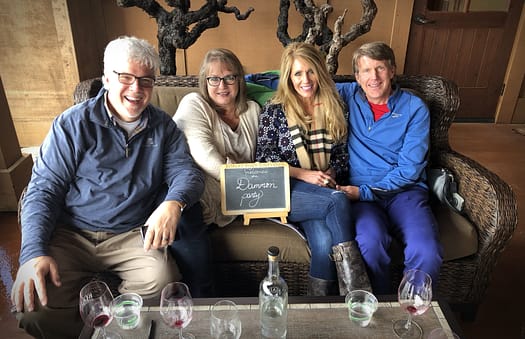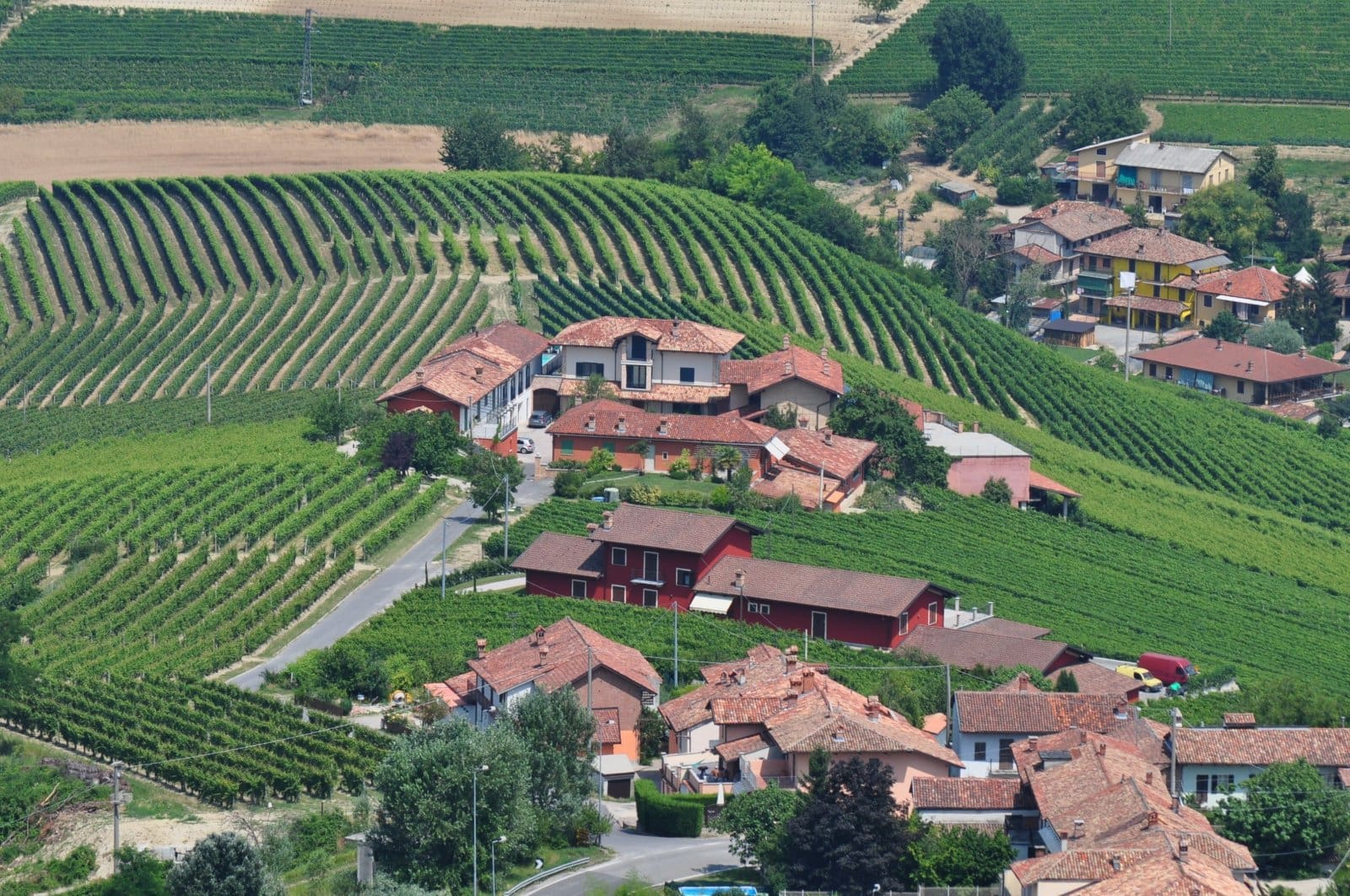
What is the most important ingredient in a bottle of wine? We could spend an entire evening debating the answer to that question. Of course the grapes account for much of that equation – varietal, viticulture, vinification – as does terroir, vintage effects (weather, etc.), fermentation choices, aging, etc. But I’m thinking of a much more esoteric ingredient, and I hope you’ll agree with me. I’d say that if you start with a good foundation leveraging all those characteristics, what transforms a good bottle of wine into a great bottle can be any of a variety of more esoteric ingredients.
Tonight, I’m specifically thinking about hospitality. As I think back over all the bottles of wine I’ve enjoyed (and there are many) I can honestly say that the most consistent ingredient in those bottles that rise to the level of distinction in my memory are those shared with friends new and old over meaningful conversation and fellowship.

I was reminded of that common thread one afternoon last fall when Lisa and I were in Napa with some of our traveling buddies. Lisa had been there for a few days on a business junket and the three of us (Tom, Jules, and I) flew out to join her for an extended weekend.
During our introductory glass of sparkling wine at Domaine Carneros (our traditional start to every Napa weekend), Lisa mentioned that she had met a woman at her business event (a gathering of high end meeting coordinators, venue representatives, etc.) who had – with her husband and family – recently purchased a vineyard in Sonoma and were nearing their initial release of a couple of wines. This woman (Marla Bedrosian) had invited us to come out and taste a bottle or two prior to the release.
Now if you know us, you understand that while Lisa isn’t a total introvert, I am so far out on the extravert spectrum that I make most politicians look like shrinking violets. But although some of our greatest adventures have been discovering wines you won’t read about in the major publications, I wasn’t overly excited about making the trek to Sonoma to meet a rookie winery owner just on a random invitation. I mean, come on! We were in the capitol of U.S. wine culture. Why go out of our way to find an unproven, unknown winery? Dime a dozen, right? Boy, was I ever wrong.
Since we were going to make the drive over the Mayacamas range into Sonoma to visit Jordan Winery (one of our favorites and the subject of an upcoming blog post) I reluctantly agreed to venture further into the Sonoma valley on a rainiy afternoon at Lisa’s request to visit the Bedrosians’ Domaine De La Riviere.

I should have realized something special was about to happen as we pulled up to the Bedrosian’s Sonoma home – a double rainbow appeared over the rolling vine covered hills and I began to wonder if there might actually be a pot of gold waiting for us. Unfortunately, in this fairly remote part of wine country, infrastructure is less than fully developed and sometimes even a light rain means a power outage – as it did on that afternoon.

As we pulled into the circle drive in front of the house, though, Marla flung the front door wide and heartily welcomed us to her “home away from home” insisting that we come through the darkened house and see the incredible view of the double rainbow from her back patio. Indeed, it was an incredible view as the rain-washed air glowed with the low angled sunlight across golden rolling hills blanketed with vineyards. One of those magic, golden moments that can never be planned, only experienced.
As the rainbow faded into the mist, Marla welcomed us back inside her home now illuminated with what must have been dozens of candles. She had prepared glasses and a taste of some local cheeses to accompany her wines. And the tasting began.
I have to say that my expectations were low. I mean, who among us hasn’t dreamed of just moving to Sonoma and starting a winery? But as my old gaffer used to say, “There’s many a slip ‘twixt the cup and the lip.” In other words, good intentions and a dream do not a quaffable wine necessarily make. So when Marla poured a generous taste of this first release of Domaine De La Riviere’s signature Shoshona Rose and Chardonnay, I was ready to be underwhelmed.

And then . . . and then . . . Marla began to speak about the wine. About how she and Geoff had a dream of leaving behind a busy New York lifestyle and cultivating a passion for good wine and good living. About how sons Duff and Zak and daughter Shoshona (yes, Shoshona is Hebrew for Rose and the name of their blush release) each have found their place in the winery . . . no small feat for a generation frequently “dinged” for being easily distracted and difficult to entertain. About how winemaker Kale Anderson was taking a chance with this adventurous family.

As the evening shadows lengthened in the candlelight and four old friends and one new one shared some surprisingly tasty and character-rich wines and, more importantly, some great conversation, I discovered (or perhaps re-discovered something I’d know all along) that there is a direct relationship between the quality of wines and the hospitality of the environment in which they’re shared. It’s a phenomenon that I’ve validated again and again. And, thankfully, one that is easy to recreate.

So thank you, Marla Bedrosian. Thank you for your wine. Thank you for the adventurous spirit that led you, Geoff, Duff, Zak, and Shosh to take a chance on yourselves, on Kale Anderson, and on Vineyard 11 (the family ranch). But thank you most of all for your hospitality. For the sense of wonder you shared with us that afternoon over a double rainbow. For the conversation around your kitchen table while sharing your wine. Thank you for making that initial invitation to Lisa. You’ve earned a fan (or four) not just of your wine, but of your story.
And to all our friends – those we’ve known forever and those we’ve yet to meet – I hope you’ll always find good wine seasoned with conversation, fellowship, and hospitality at the Dammon home. As I tell everyone – we’ll keep opening bottles until we find something you enjoy. And I’ll bet some of those bottles will be Domaine de la Riviere.


 Toward the southern part of the Piedmont, nestled up against the Appenines and draped over hills where the fog in autumn slides in like a protective blanket against the coming (often snow-filled) winters, you can find the Nebbiolo vineyards of the Barolo DOCG, Italy’s “King of Wines.” That’s quite a reputation to live up to, considering that there are 59 different wines designated as DOC (Denominazione di Origine Controllata) or DOCG (Denominaze di Origine Controllata e Garantita) – in the Piedmont region alone.
Toward the southern part of the Piedmont, nestled up against the Appenines and draped over hills where the fog in autumn slides in like a protective blanket against the coming (often snow-filled) winters, you can find the Nebbiolo vineyards of the Barolo DOCG, Italy’s “King of Wines.” That’s quite a reputation to live up to, considering that there are 59 different wines designated as DOC (Denominazione di Origine Controllata) or DOCG (Denominaze di Origine Controllata e Garantita) – in the Piedmont region alone. ome a leader in this innovation – innovation for which he paid quite a price in the early days of the Barolo revolution, even to the point of being disinherited by his traditionalist father at one point for his progressive views and actions. That paternal treatment seems less harsh when you learn that Elio, in an effort to get his father to leave behind his traditional methods, took a chainsaw to the old, decayed, over-used and definitely un-hygienic barrels in the family winery! Eventually, Elio was restored to favor, and he brought significant changes to the family’s wine making including banning all pesticides and focusing on the health of the soil and the vines in addition to cleaning up the winery and improving vinification techniques.
ome a leader in this innovation – innovation for which he paid quite a price in the early days of the Barolo revolution, even to the point of being disinherited by his traditionalist father at one point for his progressive views and actions. That paternal treatment seems less harsh when you learn that Elio, in an effort to get his father to leave behind his traditional methods, took a chainsaw to the old, decayed, over-used and definitely un-hygienic barrels in the family winery! Eventually, Elio was restored to favor, and he brought significant changes to the family’s wine making including banning all pesticides and focusing on the health of the soil and the vines in addition to cleaning up the winery and improving vinification techniques. es a dilemma. Do we (Lisa and I, since of course they are HER wines, too!) enjoy these individually, each worthy of it’s own slow, lazy evening of appreciation? In my mind I’m immediately transported back to many evenings in Italy where the wine, the conversation, the poetry, the music all dissolved into a perfect starlit Tuscan sky. Now that’s compelling!
es a dilemma. Do we (Lisa and I, since of course they are HER wines, too!) enjoy these individually, each worthy of it’s own slow, lazy evening of appreciation? In my mind I’m immediately transported back to many evenings in Italy where the wine, the conversation, the poetry, the music all dissolved into a perfect starlit Tuscan sky. Now that’s compelling!
























